Text
WWE 2K24 Review: Few Steps Forward In A Thousand Mile Walk
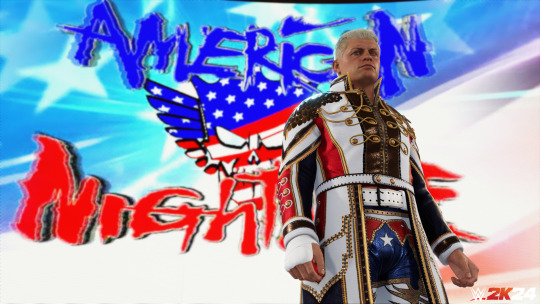
WWE 2K24 marks the latest installment in the annual WWE video game franchise, bringing forth a fresh array of changes and features that the marketing team eagerly showcases with pride. The standout feature in this year's release is the "2K Showcase Of The Immortals," a celebration of 40 years of WrestleMania events. Fans may recall a similar endeavor in WWE 2K14 with the "30 Years of WrestleMania" Showcase mode.
Adding to the excitement, WWE 2K24 introduces new match types, including Special Guest Referee, Ambulance Match, Casket Match, and various Gauntlet Matches. The game proudly presents two fresh MyRise stories: "Undisputed" for the Men and "Unleashed" for the Women. Additionally, MyFaction has seen a complete redesign for Faction Wars as well as the addition of “Persona Cards”, which unlock throughout the entire game. My long-time followers know that I was not very fond of WWE 2K23 and didn’t play beyond 40 hours, so how does WWE 2K24 stack up to it?
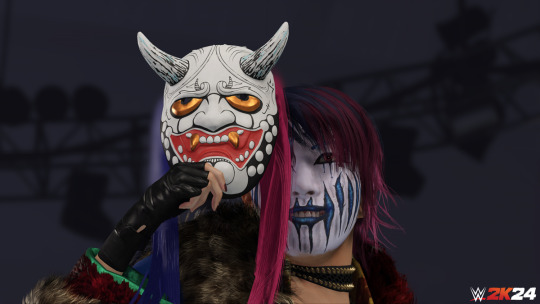
Let's delve into the presentation and graphic fidelity first. I'll admit, there's a noticeable enhancement in all shaders across the board, delivering a sharper and more vibrant aesthetic. Notably, wrestler skin textures exhibit increased grain and sharpness, lending them a realistic appearance under diverse lighting conditions. The hair alpha rendering shader has significantly expanded, moving away from the plastic look of previous years, with tweaks to the opacity layer ensuring individual strands stand out prominently. From a technological standpoint, WWE 2K24 marks a substantial improvement over the past two years of WWE2K.
Gameplay showcases WWE arenas with an improved depth of field, creating the illusion of a vast sea of enthusiastic WWE fans, regardless of the venue's size. The refined camera enhancements even elevate seemingly mundane elements like the Los Angeles Wrestlings' band kit in the background, making them visually appealing.
The attires and gear textures on the wrestlers are nothing short of incredible. Changes to the PBR rendering system introduce more variation in shine and detail across the board. Wrestler tights no longer appear eerily similar in material in-game, bringing them more in line with their real-life counterparts. These improvements let the light engine truly highlight the extravagant, over-the-top outfits seen in WWE programming, from Axiom to Xavier Woods. However, when it comes to graphics, technological fidelity marks the endpoint of WWE 2K24's positive strides.
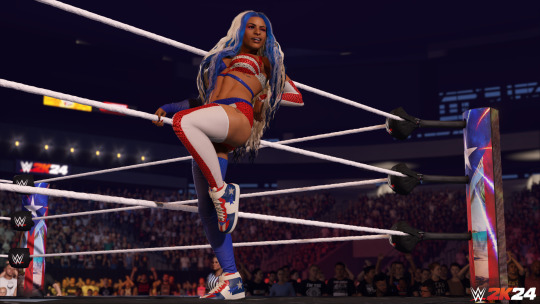
It appears the franchise has enlisted a new Art Director, instigating significant changes that have caught the attention of eagle-eyed veterans like myself. Unfortunately, a notable drawback in this year's installment is the widespread adoption of 2K's "MetLife Stadium" proxy template for the surrounding stadiums of almost every large interior arena, including WrestleMania 39, Backlash 2023, and Clash at the Castle. This uniformity contrasts with previous years, where even WWE 2K23 displayed more diversity in venue stadiums.
This becomes glaringly obvious in "2K Showcase of The Immortals," where almost every match unfolds against the exact same background. Whether it's Hulk Hogan vs The Ultimate Warrior at WrestleMania 6, Kurt Angle vs Shawn Michaels at WrestleMania 21, or Cody Rhodes vs Roman Reigns at Wrestlemania 39, the background stadium remains identical. No effort was invested in recreating even a visually similar proxy of these iconic WrestleMania venues.
To exacerbate the situation, some attempts *actually* were made to recreate iconic WrestleMania shots, but they missed the mark. Take, for instance, the Shawn Michaels vs Razor Ramon Ladder Match at WrestleMania X, which is disappointing for multiple reasons. The surrounding venue still relies on the MetLife template, but they added a second entrance ramp blocked off to showcase the WrestleMania X logo during the match, mimicking the broadcast. Unfortunately, due to the use of the MetLife template instead of the available Madison Square Garden template in Create-An-Arena, the entrance ramp appears disproportionately long compared to WWE 2K14's similar workaround. Wrestlemania XX, featuring Kurt Angle vs Eddie Guerrero, employs their "Fleet Center" template with the Madison Square Garden roof awkwardly placed on top. Yet, they did not put the MSG roof on the Wrestlemania X venue.
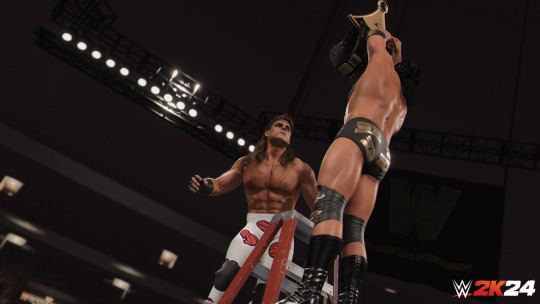
All these issues strongly indicate that Visual Concepts brought in an art director who seemingly lacks any genuine interest in pro-wrestling or the historical significance of the venues hosting these iconic moments. We're not asking for licensed stadiums akin to NBA2K; we're simply pleading not to be greeted by Raymond James Stadium when entering WrestleMania 31, especially considering a past WWE 2K entry accurately used Levi's Stadium. The entire situation feels like an elaborate practical joke, particularly with the once beloved "Japan Dome" arena, a decade-long fan favorite for mirroring the real Tokyo Dome, now bizarrely transformed into MetLife Stadium by this peculiar art team. Should this not see improvement in the next entry, it forebodes a grim future for the artistic integrity of the franchise.
Now, turning our attention to Showcase, this mode makes a grand return, larger than the past two years but unfortunately, just as disappointing, if not worse. While I hold immense respect for the Showcase director as both a person and a wrestling enthusiast, I understand that the decisions concerning this mode aren't entirely within his control. Regrettably, Showcase has evolved into something almost unplayable, generating genuine animosity from the majority of the WWE 2K fanbase. This isn't an exaggeration; it's a fact. The discontent with Showcase spreads like wildfire on Twitter, YouTube, and TikTok, yet remarkably, little is done to address the inherent problems in this mode.
For years, concerns have been raised about the oddly specific move objectives that are neither fun nor enjoyable. Cutscenes in the Slingshot Tech are largely overlooked, as they fail to spark excitement or pleasure; instead, they become a tedious slog to endure. The only reason anyone engages with it now is out of sheer necessity for unlocks and nothing more. Specific matches aren't worth delving into in this review because they all unfold in a similar fashion: spam damage objectives, attempt oddly specific moves the AI will likely reverse, spam moves to build a finisher for a cutscene, repeat about three more times, and then the match concludes. It's utterly absurd, and in the interest of full disclosure, I admit I couldn't bear to complete Showcase for this review, stopping after Undertaker vs Shawn Michaels at WrestleMania 25.
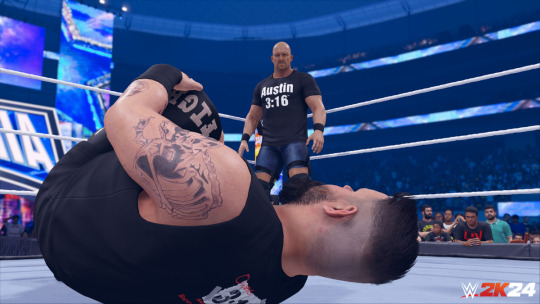
The concept of a historical showcase celebrating WWE's past is not inherently flawed. We embraced it when it was introduced, enjoying it for several years before it morphed into its current state. Even Showdown: Legends of Wrestling incorporates a similar feature. The key difference? WWE 2K24 presents the worst possible iteration of it. Allow us to "rewrite" history and play our own matches, following the model set by WWE 2K14. Set the scene for The Rock vs Stone Cold, specify the winner, and provide one historical objective, like "Put The Rock through the announce table." We genuinely don't need anything else. Abandon the Slingshot Tech buzz, discard the real-life footage, and bring back entrances! That essentially sums up Showcase because, truthfully, it's just that uninspiring.
MyRise returns with two gender-specific stories. The Men's Division tale, "Undisputed," unfolds as Roman Reigns retires from WWE to pursue Hollywood, while a "Dark Horse" endeavors to break his record. On the Women's Division side, the "Unleashed" storyline follows the journey of "The Captain" from an indie promotion, TBD, as she gets signed to WWE, aiming to prove herself in the big leagues. In terms of writing, MyRise exhibits a notable improvement and overall enjoyment this year. The dialogue steers clear of the cringey moments of previous years, and the satire resonates more realistically, aligning with real-world elements.
The "Undisputed" MyRise story had me captivated from start to finish. While it has its occasional moments of tedium, the overarching backdrop story and the challenges your character faces immerse you in the role-playing experience, ready to confront any challenger for the Undisputed Championship. This includes a prolonged feud with Cody Rhodes, stretching from the story's inception to practically its conclusion. Roman Reigns plays the overarching villain, consistently engaging with your character through tweets or video messages from a movie set that oddly always looks the same. Nonetheless, "Undisputed" keeps the plot in constant motion, introducing supporting characters with their own mini-arcs, like The Miz, who persistently poses challenges as the Smackdown GM. As well as Gigi Dolin, who plays the part of your wife in an arranged marriage. Gigi does pretty good in her voice role, too.
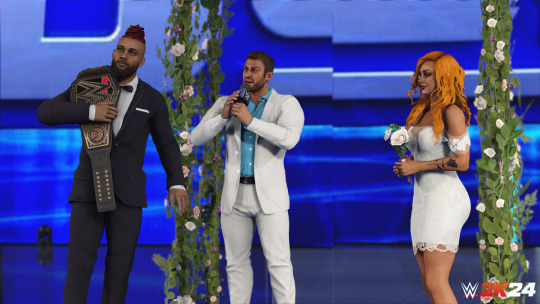
Regrettably, I cannot express the same sentiment for "Unleashed," which fails to deliver the same sense of progression and evolving plot with supporting characters beyond its initial chapter. As "The Captain," leader of the indie promotion TBD, you escort one of your pupils to a WWE Audition in Las Vegas, eventually securing WWE contracts for both of you. Initially, the story paints a compelling narrative, immersing you in the struggles within WWE's corporate confines. However, this promising setup takes an abrupt turn for an experimental storytelling device labeled "Explore Stories." These side-stories bring the game to a grinding halt, feeling like narratives either scrapped from another year or hastily concocted. The Movie-Star subplot, with its seemingly endless monotone matches and lackluster humor, led me to the decision to preserve my sanity and leave the Women's MyRise unfinished for the time being.
A significant flaw in the MyRise system, in general, is its User Experience (UX) and the incessant loading screens that disrupt the flow. Moving from one match to the next feels like wading through virtual molasses, especially with the added dialogue options. Moreover, the game heavily relies on the Social Media feature, and disappointingly, developers do not offer the option to skip text message conversations. Consequently, a substantial amount of time in MyRise is squandered waiting for virtual characters to finish typing their virtual messages. If these stories were solely matches, completion time would range from 4-6 hours. However, the snail-paced progression of this mode extends the experience, making it feel like a daunting 24-48 hours. While MyRise is a robust mode worthy of retention, much like Showcase, a comprehensive rethinking of its format is imperative.
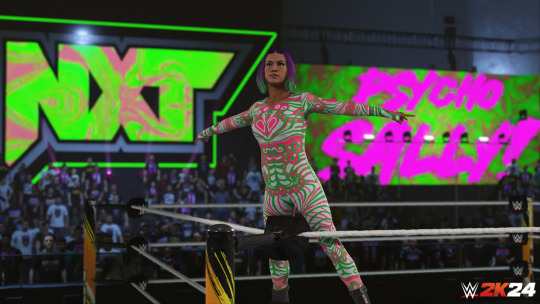
The final aspect I'd like to delve into in this review is the gameplay mechanics of WWE 2K24. As someone who quickly grew weary of 23, I can confidently say that 24 exhibits a significant improvement in general fluidity and balance changes. A persistent issue in the past two years was the monotonous cycle of "build to Signature, do Signature, do Finisher, waste their Resiliency, repeat if the AI allows." I'm pleased to report that this cycle is mostly shattered, thanks to substantial gameplay changes that inject much-needed variety into matches. The Resiliency Payback can now only be assigned to wrestlers with an 85 or higher, and the AI tends to use it less frequently, deviating from the previous 100% chance. Moves transition more seamlessly, and Irish Whip rebounds are notably enhanced with the new move queue system. The introduction of new vocality in referees and superstars contributes to a more realistic presentation. Additionally, new Paybacks and tweaks to existing ones provide increased gameplay variety among different wrestlers. However, the persistent issues that have plagued the franchise since Patrick Epilog was the producer persistently undermine the core gameplay mechanics.
The Stun Meter remains a critical point of contention, requiring either a complete philosophical rewrite or elimination altogether. It's inconsistent and seemingly serves no purpose. It adds zero value to the game's mechanics in any way, shape, or form. Notably, it doesn't adjust its Stun Length based on damage, merely existing in the game without contributing meaningfully. While the concept of a stun meter is not inherently flawed, its execution in WWE 2K24 falls short. Showcase: Legends of Wrestling incorporates a stun meter as well, but theirs is an active mechanic, allowing players to mash out of the stun with agency. Unfortunately, the same cannot be said for WWE 2K, where being stunned feels like a forced interruption, prompting me to put down my controller and check my phone notifications. It appears to serve no valid purpose other than to literally penalize the player, disrupting the game experience for no apparent reason.
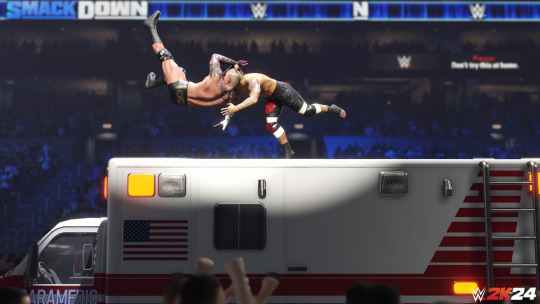
On a positive note, AEW: Fight Forever seems to have spurred the developers into action, prompting substantial improvements to tag team match gameplay in WWE 2K24. A host of mechanics and balance changes have rejuvenated the Tag Team experience, making it a more enjoyable aspect of the game. A crucial addition is the new rule dictating that an illegal partner may only interfere once before being tagged again. This change streamlines 6 and 8-Man Tag matches, making them more stress-free by allowing players to isolate a single opponent and bait interferences with pins. The strategic shift then centers around denying the opponent the tag until you can execute your finisher. Moreover, the game introduces new commands on the left bumper button, enabling players to instruct their illegal partners to attack the opponent partners or retrieve weapons from under the ring. While it may not reach the fluidity of tag matches in AEW Fight Forever, these improvements render MyFaction worthwhile and enjoyable to play.
However, a bothersome addition is the new "Trading Blows" feature, which can be triggered at any time by holding the strike button. This essentially forces the player into a somewhat silly mini-game where they need to stop the strike button within a small zone. The visibility of this zone is further hampered by a random shake of the widget, making it challenging to view. This Trading Blows mini-game brings a complete halt to what could be a momentum-filled matchup, reminiscent of WWE Television. On television, "Trading Blows" is only seen when two wrestlers are incredibly tired and attempting to recover from an offense. It's peculiar that for a game emphasizing realism and simulation, the AI can employ this mechanic to turn the tide at any time, regardless of our health bars. While this feature can be turned off for Offline Play, it can't be for MyFaction -- which I spend most of my time in.
The reality is that losing against the AI in WWE 2K is not an enjoyable experience because the core gameplay is not designed with the player's enjoyment in mind. It feels like a poorly executed attempt to turn something that should be pleasurable and fun into a burdensome competitive chore. The Counter/Reversal system consistently begs for a ground-up rewrite, as prompts and windows are unreliable, often failing to appear. Certain running moves can be easily missed if the button is pressed a millisecond too early, without any queuing for when the player is close enough. Strike distance feels unusually low, resulting in simple actions like a kick missing when it logically shouldn't. The WWE 2K series is hindered by overly complex controls, with many mechanics layered onto the same button, leading to instances where the player's attempts just won't work at all. Returning to the AI comment, they frequently pull off miraculous comebacks that the player struggles to counter, exacerbated by failing prompts and a lack of defensive variety, such as rolls and kneeling grabs, which are available in AEW: Fight Forever.
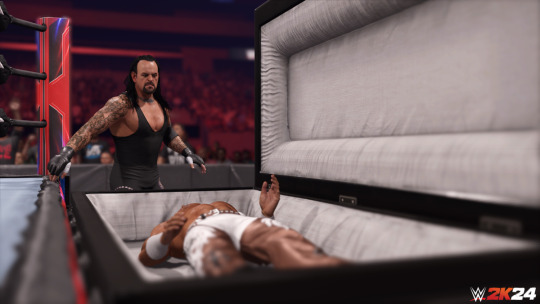
In games like Elden Ring, losing to the AI is still seen as enjoyable. Players accept their defeat with sentiments like "fair play" and acknowledgment of the AI's well-programmed tactics. The experience is shaped by knowing it was their own fault, as the Boss AI expertly combats the player while maintaining its own strengths and weaknesses. Unfortunately, the same cannot be said for losing in WWE 2K. Losses often result from the AI executing a miraculous beatdown out of nowhere, with defense options failing or being unavailable due to the problematic stun meter. It's challenging to express this sentiment adequately in text, but the feeling is that losses seldom occur due to a fair competition of technical wrestling. Instead, they usually stem from the AI exploiting situations that shouldn't have happened, leaving the player unable to recover and leading to defeat. The fact that countering moves is bound to four different buttons, including combo breakers, highlights the need for serious streamlining and simplification of controls and associated commands in the game. The pursuit of realistic situations and attacks is draining the fun from the franchise.
I’m not much of a creator on these games so the Creation Suite isn’t going to get talked about much from me. They are generally identical to previous years, aside from newly added clothes to Create-A-Wrestler and props to Create-An-Arena. There have been no significant changes to any of the creation modes. However, 2K did implement a new “Create A Sign” feature, allowing players to create custom crowd signs for their created wrestlers. This feature is very fun and adds a dimension of comedy to the game, as one of my first orders of business with it was importing Dakota Johnson’s face as a poster for my Madame Webb “CAS” in MyRise. Overall, if you were happy with the creation suites, you’ll be happy again.
As for MyFaction, it undergoes significant improvements across the board. Addressing criticism of MyFaction exclusivity for certain characters, some MyFaction cards now feature a "Persona Badge," allowing their use across all game modes. However, there are still numerous cards without the Persona Badge that should have one, such as the MyRise Original Characters. Faction Wars undergoes a complete revamp, shifting from a tower of 4 versus 4 matches to a rogue-lite style node-travel run that requires tickets for entry. This version of Faction Wars rewards credits, which can be used to purchase the Boss Cards defeated in Faction Wars runs. It proves addictive and serves as a refreshing change of pace from previous iterations.
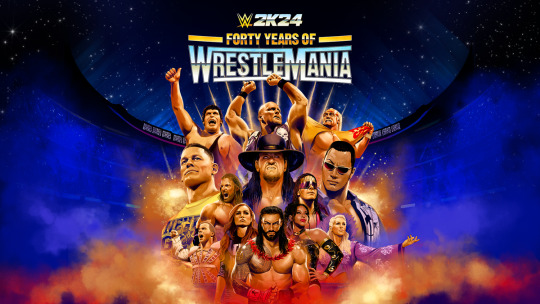
Truth be told simply; WWE 2K24 stands as the Head of the Table of the 2K Franchise. But in reality, that doesn’t mean much. It’s only real competition is itself. WWE 2K24 is not a bad game; it stands as a commendable entry into the franchise, with some players likely forming fond memories due to new additions like the Ambulance Match. However, the new match types feel somewhat like novelties, possibly meant to divert attention from the gameplay weaknesses. The graphic fidelity sees a notable upgrade in this entry. Despite its flaws, Showcase still offers an array of fantastic attires and unlockable models for Exhibition and Universe. MyRise is worthwhile for the unlockables and experiencing at least one of the stories to obtain quality MyFaction cards. The gameplay brings fantastic balance changes, even though the core foundation still needs work. If you enjoyed WWE 2K22 or 2K23, you will likely find enjoyment in 2K24. However, if you were hoping for a substantial overhaul, it's time to acknowledge that these games may no longer cater to your preferences. While the game's presentation is finally on par with its sister, NBA 2K, the engine and foundational gameplay have a way to go before being considered as culturally significant to WWE as it is to NBA.
Note: A free review copy of WWE 2K24: Forty Years of Wrestlemania Edition on Xbox One X was provided by 2K.
#wwe#wwe 2k#wwe 2k24#wwe 2k24 review#wwe 2k review#gaming#game review#review copy#xbox one x#wrestlemania#wwegames
0 notes
Text
The Potential Funeral Of AEW Fight Forever
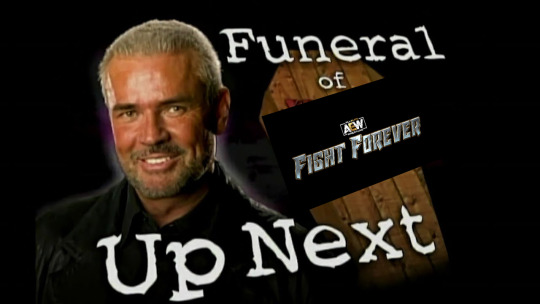
For my regular readers, you may recall my previous article where I detailed all the ways AEW: Fight Forever could become a fantastic, highly-competitive Ranked Fighter if they marketed it correctly. Unfortunately, they didn't get anything right. Within the first two weeks, the game experienced a massive decline in active players, especially on PC, going from around one thousand concurrent players to just 50 at any given time, according to VGInsights. The lack of promotion from THQ Nordic and AEW themselves has killed what could have been a special alternative to WWE 2K.
Fans have noticed that Kenny Omega has not personally promoted the video game or been seen playing it publicly. The lack of enthusiasm from the game's "grandfather" reflects on the fans' lack of motivation. If Kenny doesn't care, why should we? What happened to the enthusiasm from the original AEW Games Conference?
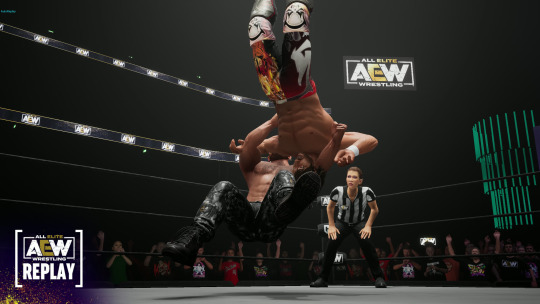
The only person championing the game on social media is Justin Leeper, the designer of RTE, who doesn't even work at Yukes anymore. Kenny doesn't care, THQ doesn't care, and frankly, I'm done caring. THQ employees don't tweet about playing it or stream it. Perhaps they are bored of it, or maybe they never cared about wrestling in the first place and just wanted another gem in their "Infinity Gauntlet" of collecting original THQ properties.
It's not just the marketing that killed the game; it's also the fact that a whole season of downloadable content was announced in mid-June. The game was released on June 29th, and as of writing this article in August, there has not been a single notable update to AEW: Fight Forever, and the DLC has been indefinitely delayed.
It's baffling that Yukes released a game where the main focus is supposed to be online play, yet they couldn't create a balanced and functional experience for players to enjoy. Online matches are dominated by unbalanced skills and overpowered Created Wrestlers, along with rage-quits that completely ruin the experience. We'll delve deeper into these issues shortly.
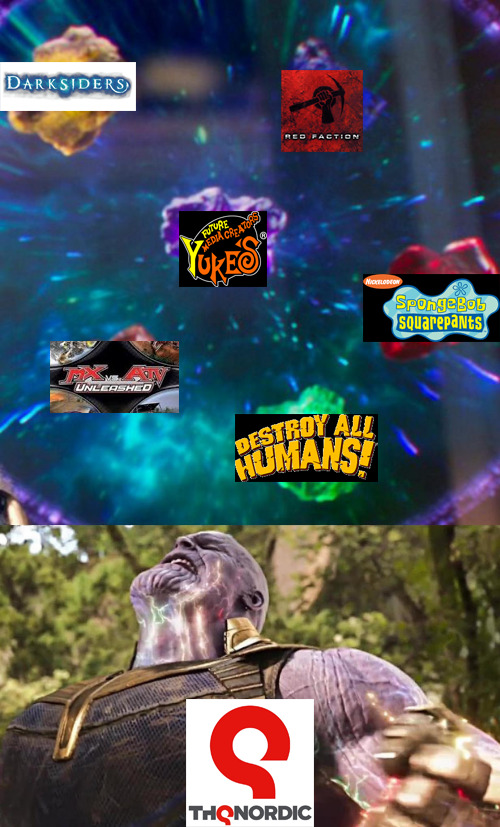
And even after all these problems, THQ Nordic's Zyddie and Jen Bigell have yet to provide any real glimmer of hope. It appears that the same issues that existed years ago with WWE, such as Yukes' inability to communicate with their publisher, are plaguing this game once again. As a source of mine pointed out when they announced Fight Forever, “Tony just inherited a developer with 20 years of wrestling game experience. He doesn’t realize he also just inherited all the problems that made 2K fire them.”
The Failure Of Marketing
The complete sales data of modern video games is no longer readily available, as publishers now consider playtime a success metric instead of complete sales numbers. Unfortunately, AEW: Fight Forever has fallen short in both aspects, according to algorithm estimates and available data. It debuted at #3 on the UK charts and sold an estimated 20,000-30,000 copies in the first week, which seems lukewarm considering the minimal competition. The report suggests a revenue of $900,000. Data for PC is more widely available, indicating that the game initially had over one thousand players but has now dipped to an average of 50 at any given time. VGInsights' algorithm estimates that nearly thirty thousand copies have been sold.
According to Dave Meltzer, AEW invested around ten million dollars into the game. The contributions from Yukes or THQ are not known, but as more delays occurred, the game became more expensive. According to Mike Straw's report from August 2022, the game was already "way over budget" and required further investment, presumably from AEW's side. This doesn't include any marketing budget, which likely involved significant expenses for hiring film crews and traveling to AEW shows to film segments with their wrestlers.

The game isn't selling as well as Tony Khan or Kenny Omega had envisioned, partly due to THQ's marketing strategy primarily relying on social media. It's a peculiar situation, as everything appeared promising over a year ago when they participated in events like GamesCom and Tokyo Game Show, setting up rings and hosting matches for convention crowds. The THQ Nordic that handled those events seemed to have a different attitude compared to the one that started marketing the game in late May.
I have always supported the theory that sometime in the Fall or early Winter of 2022, THQ lost complete confidence in Yukes' ability to deliver a profitable product, leading them to give up caring. Mike's report somewhat supports this theory, with statements like "Because of how things have gone during the development of AEW Fight Forever, there are some on both sides of the fence believing this may be a 'one and done' arrangement between AEW and Yuke's." If you analyze the behavior of THQ and AEW over the past year and observe how their attitude towards the game has changed, you'd realize this is probably not some far-fetched conspiracy.

Once the release date was announced, all THQ Nordic did was post entrance videos and finishers on Twitter. While I did mention in my previous article that they should do this, they did nothing else in an attempt to sell the game to millions of wrestling fans. No billboard advertisements in New York or LA, no real television spots, no short films, no tournaments—just clips. To someone analyzing video game marketing, it appears that they wanted the game to fail so they could potentially get a tax write-off or something similar.
Another interesting piece of evidence supporting this theory is that they completely neglected to market the Stadium Stampede mode before the game's release, which was an absolutely foolish decision. I had to leak the fact that Stadium Stampede even existed as a Battle Royale mode on Twitter through early datamining, before THQ even acknowledged its existence in the game. The tweet received mainstream coverage on almost every notable gaming website, yet for some reason, Zyddie (THQ representative) tried to deny it on the Discord server, dismissing it as a "rumor." Several people informed me that they pre-ordered the game solely because this mode was included. THQ didn't release a trailer for Stampede Mode until a few days after the game's launch and failed to provide any sort of timeframe for its release. As of now, in August, there is still no timeline for when this mode will be available to fans. A monkey dancing in an AEW Fight Forever T-Shirt on Twitch would likely generate more sales than the entire marketing effort THQ put into the game. The issue of the delayed Stadium Stampede mode leads us directly into our next section.

Indefinitely Delayed Content
In my previous article, I emphasized the need for complete transparency from THQNordic if they want to retain their fans. Once again, they have failed to listen. They promised a platform game with ongoing updates, yet provided no clear roadmap for this content. There are no dates for its release, and no updates on the progress of the content. Their refusal to take responsibility for the lack of communication and content highlights once again that corporations do NOT care about their consumers.
Regarding Stadium Stampede, there has been no update on its release timeframe, and players have no indication of how it functions or what to expect. The Battle Pass, which I previously leaked, has also not been officially confirmed to exist. It's incredibly baffling how this mode wasn't the central focus of the game's marketing campaign to attract the Fortnite crowd and hardcore battle royale fans. Although fans still eagerly await this mode, it's unlikely to bring back the majority of those who have already left.
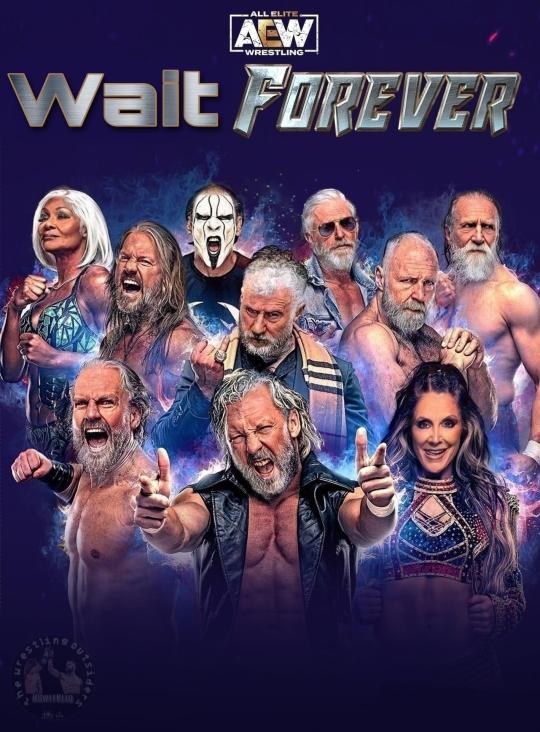
While THQ continues to post random gameplay trailers on Twitter in an attempt to entice more purchases, some of these trailers hint at new content, such as a red Chris Jericho attire or new facepaint for Sting. However, it remains unclear if these items are definitely coming in an update or were accidentally showcased from a beta build. Why? Once again, THQ chooses to remain silent and fails to provide any information to their consumers. When will we get these items? How will we unlock them? Are they free or included with the Season Pass? There are only questions and no answers.
The most egregious issue of all lies in the Downloadable Content situation, where THQNordic is attempting to deflect blame, subtly pushing it onto Yukes – a developer with a 20-year history of incompetence. Regardless of how fun or enjoyable some may find the old WWE games, the fact remains that every single one was poorly programmed, including up to 2K19. Yukes is not known for being a good developer, and anyone claiming otherwise likely knows little about game development. In Japan, they have not secured any major gaming projects in their own country.

THQ Nordic announced the first Season Pass in mid-June, and to their credit, the official press release did not include specific dates. The content included FTR, Keith Lee, The Bunny, and Hookhausen. However, the content was registered on the Nintendo eShop later that day, and the eShop indicated that the Limitless Bunny bundle would release on July 25th, while the Hookhausen bundle would release on August 22nd. These dates were widely reported by major wrestling and gaming news pages, and there was no reason for anyone to doubt them. What's worse is that THQ Nordic never made any effort to correct these projected release dates on any website, and they remained circulating for over 4 weeks without correction.
As July 24th approached, fans were left wondering if there would be any marketing for the DLC, given its imminent release on the next day. Finally, THQ Nordic released a statement. While I appreciate Zyddie, the THQ Community Manager, for his efforts, he simply isn't the right fit for this job. He lacks knowledge of wrestling and the expertise to handle comments from the wrestling community. Moreover, he doesn't fully understand how experienced wrestling fans are in dealing with community managers and seeing through insincerities. Unfortunately, he has been mocked by the community, especially for his misunderstanding of "dog collar matches," where he believed it involved actual dogs. This mistake has been a constant source of ridicule. Anyway, here's the statement that was released about the Keith Lee bundle.
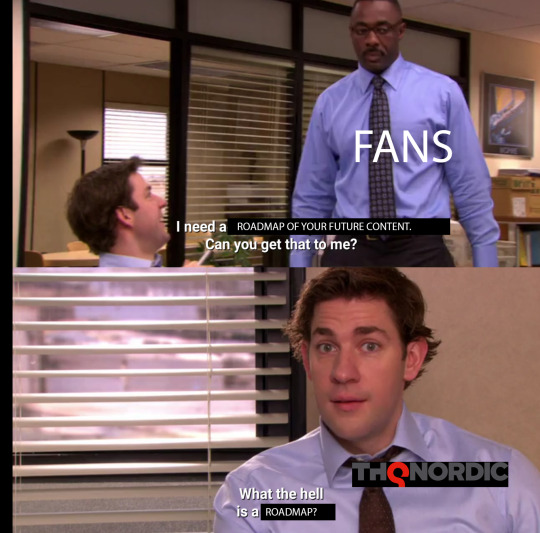
"There are currently no confirmed dates for the upcoming DLC. The placeholders at Nintendo are not accurate." First off, it's rather audacious to throw Nintendo under the bus and suggest that they "made shit up." I attempted to reach out to Nintendo for comment on the origin of these dates, but unfortunately, I received no reply.
"We are working to ensure the DLC is released as soon as the game is ready for it. Rushing the DLC could lead to serious issues, so we prefer to ensure a smooth implementation of new content." To an innocent reader, this statement might imply that the DLC is just taking more time. However, with my knowledge of Yukes and wrestling game history, I can read between the lines. The subtext here suggests that Yukes is unable to deliver the content within the dates they initially projected. Nintendo doesn't arbitrarily create dates; those dates were provided to them by the developers. They believed those dates, but later discovered that Yukes couldn't meet them. To quote Anakin Skywalker, "I see through the lies of the Jedi."
Customers who purchased the Season Pass and the Elite Edition are understandably upset that Keith Lee or The Bunny is not yet available in their game. Not only do they have reason to be mad about the delay, but they also lack any clarity about when the characters will actually be added. Many players have abandoned the game, and it is essentially dead in the water. As we approach the year's end, numerous big games are set to release in the next four months, making it highly unlikely that players will abandon popular titles like Call of Duty or Mortal Kombat 1 to return to AEW: Fight Forever just because a couple of new characters have been added. These characters' novelty will likely wear off quickly. Players would rather engage in games with millions of active players, possibly featuring popular figures like Nicki Minaj or Homelander.
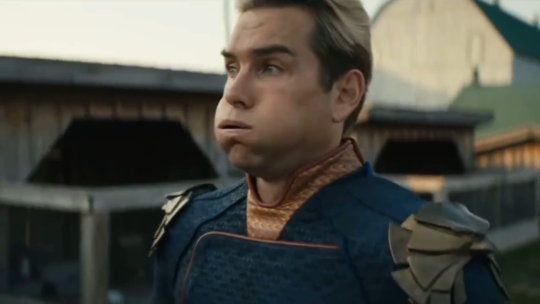
My continuous tweets highlighting the lack of communication gained significant attention within the community, and as a result, THQ had to resort to damage control by releasing a statement promising more content. However, that alone is insufficient; we need more than just promises. We require specific dates, a clear roadmap, and details about what's included in "Patch #2" to reignite interest in this game. Effective communication is crucial.
It's disheartening to observe that despite their purported "best efforts," THQ is utterly incapable of delivering what the fans want. Even WWE 2K, which is also criticized for its communication, manages to reveal some surprises ahead of time. For instance, the new 2K Showdown Twitch show informs fans about upcoming DLC packs and previews additional bonuses, such as Sami Zayn's updated music in the latest WWE 2K23 patch. In contrast, All Elite Arcade has failed to engage in any promotional efforts during their show; they merely play the game on stream. THQ does not provide them with any content to share, and as consumers, we have learned nothing about the future of Fight Forever in the past month.
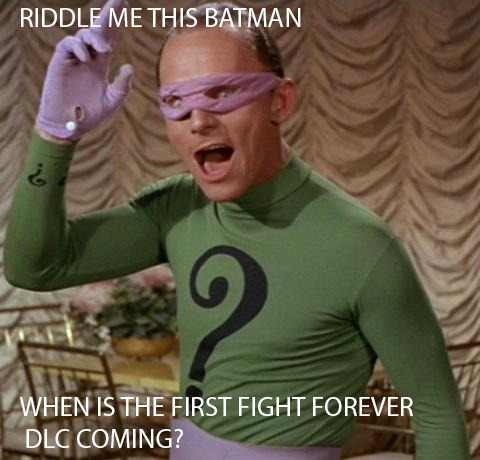
Death Of Online
I had high hopes for the Online mode, envisioning myself playing it daily and becoming one of those admired players whose matches others follow. Unfortunately, that dream never materialized because they seemingly forgot to test the Online balance before releasing the game. Yukes' failure in delivering a satisfying online experience isn't surprising, considering there hasn't been a single WWE game that fostered online competition in over a decade. AEW: Fight Forever had all the potential to become a tournament-based Ranked Fighter, but Yukes missed the mark entirely, dropping the keys to success along the way. Kenny Omega may have foreseen this outcome, which explains his lack of enthusiasm for the product he advocated to create.
One of the primary issues that emerged was the overuse of the Bail Out mechanic. As MJF, I used it strategically, role-playing his cheap heel tactics in situations that would be seen on TV. Fortunately, Bail Out has some balancing measures, such as a 5-second taunt that leaves the user vulnerable to punishment. However, during my online matches, opponents rarely capitalized on these windows and instead resorted to complaining about the perceived Bail Out spam. It is true that some users abused the Bail Out button, triggering it every time they were hit with a move, making it frustrating to mount any offense. To address this annoyance, a simple fix could limit its use online to a maximum of three times. While this is an overall nuisance, other issues were more detrimental to the demise of Ranked mode.

Firstly, the dominance of overpowered created wrestlers with "Meta" skills heavily skewed the online experience, making it difficult for fair players to mount any offense. These created characters possessed guard skills that prevented them from being downed by strikes, as well as buffs that granted extra momentum or higher kick-out probabilities. Despite Yukes' attempt to balance things by requiring created wrestlers to level up through "Road To Elite," it failed to deter players from taking these cheap characters online to secure high positions on the Leaderboards. As a result, online veterans began quitting matches as soon as they encountered a created wrestler, regardless of their stats being fair or not.
The second major problem was related to quitting matches. Even in what seemed to be a fair match with in-game roster members, some players would suddenly disconnect right after their opponent hit their finishing move. This rage quitting behavior spoiled the entire experience and discouraged players from seeking fair matchups. The penalties for rage quitting were insignificant, only resulting in a few leaderboard points being deducted, which was not a sufficient deterrent. Players were left wondering why opponents couldn't just accept the loss and take it like sportsmanship dictates.

Another significant issue arose from the game's use of peer-to-peer connections instead of dedicated servers, which probably wasn't in the budget. This choice led to half of the matches being connected to opponents with poor internet, causing severe logic lag and spirit meter desynchronization. This lag resulted in moments where players believed they had a special move available, only to realize that the meter was lagging behind, leading to unexpected outcomes during matches. The lack of a dedicated server negatively impacted the overall online gameplay experience.
During a recent feedback project, I suggested the implementation of AI to replace users who quit during online matches. Zyddie responded, stating that it would be a time-consuming endeavor, and I understood his perspective. However, it highlighted Yukes' lack of foresight in developing the game, as this feature should have been included from the start. In the past, WWE games had this functionality while Yukes was involved in their development, making it surprising that it was not part of the original design document for AEW: Fight Forever. Such messages reveal the shortcomings of Yukes in their current stage of life.
After the first week, the online mode saw a sharp decline in player interest. Even HaangEmHigh and I, who initially championed the online mode and planned to host a tournament, lost enthusiasm and steam. We both expressed our disinterest in playing online, leading our followers to feel the same way. The lack of fair competition and inadequate balance management made Ranked matches unappealing and discouraged players from engaging in online play.
Possible Future
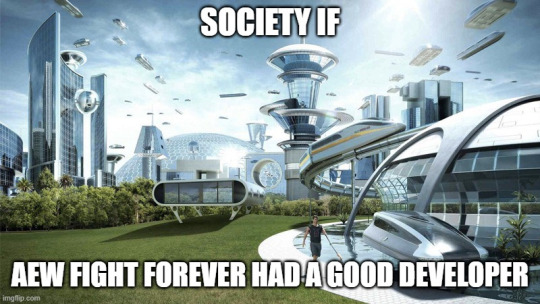
The entire situation is incredibly frustrating, especially considering how vocal I was about the need for transparency, which was never delivered. While I don't entirely blame THQNordic, Zyddie, or anyone on their team, it appears that they, too, are in the dark about Yukes and the developments in Yokohama. Their updates are often limited to vague statements like "things are in development," and it seems that's all the information they receive themselves. For instance, their questions about the whereabouts of Stadium Stampede are probably met with responses like "almost ready," but unfortunately, regardless of what comes to the game in the next three months, many fans believe it's too little and too late.
One of the main criticisms of the game is that it lacks content for offline players, and this holds true, as I mentioned in my review for WCWWorldwide. Regrettably, nothing in the confirmed pipeline caters exclusively to offline players. While Stadium Stampede is a fantastic concept, it won't affect those who don't play online. Similarly, additions like Red Jericho and other attires, though neat, are merely cosmetic changes and do not add to the game's longevity. What players desire are more matches, which is feasible considering there's an entire match creator behind the scenes. Additionally, a better "Create-A-Wrestler" suite is in demand, and while advanced morphing might not be possible, adding more items and face types to the console players' library of characters would be highly appreciated. Regarding Road To Elite, even though Justin Leeper is no longer at Yukes, expansions by a new writer could enhance the character leveling experience. However, securing funding for such endeavors may prove challenging.
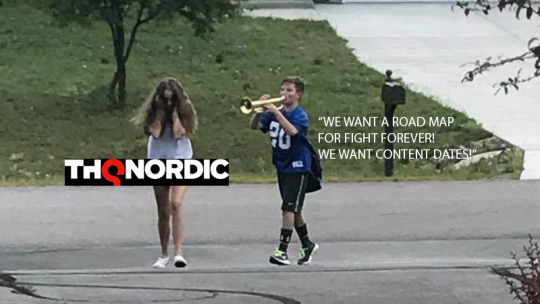
A common question I often discuss with friends is whether we might see another AEW game soon, and my honest belief is that it's insane to think any other developer or publisher would want to take on that task after this. Technically, AEW didn't do anything wrong, but the first impression in the industry is practically the only impression you get. I sometimes hear funny responses like, "Hopefully EA/[Other Huge Corp] will take them." However, that's not likely to happen. Business analysts know that big corporations require a guaranteed return on their investment, and the quick death of this game and its commercial failure means that AEW as a brand is at fault, not the game or product itself. IP (Intellectual Property) is incredibly important to the film and gaming industry now, and when an IP faces failure, it becomes tainted or blacklisted.
This can happen to even the biggest intellectual properties, like Marvel. Games like Midnight Suns, Guardians of the Galaxy (an excellent game), and Marvel's The Avengers all undersold, underperformed, and received underwhelming reviews. As a result, you don't hear about other games being announced using these IPs. The corporations believe that the brand is tainted in the eyes of the consumer. Instead, Marvel is now focusing on solo adventures, with Iron Man by EA, Wolverine and Spider-Man 2 by Insomniac. There are also rumors of a solo Black Panther game in development, as well as the Captain America/Black Panther war game. The corporate belief is now "fans don't want games based on a team or squad," and the blame will never be on themselves. Similarly, this is the case with All Elite Wrestling.
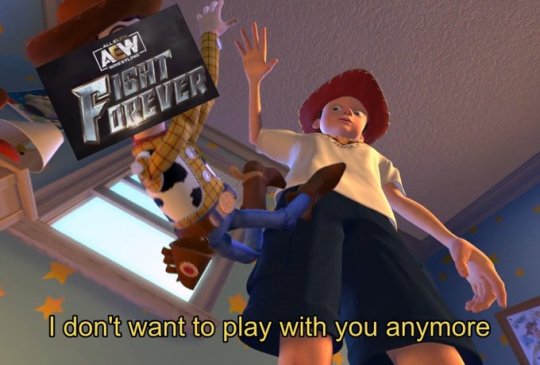
If Tony were to call up Electronic Arts right now to propose making an AEW game, they would likely laugh and hang up. The first obstacle is that mega-publishers like EA are only interested in wrestling video games if they involve the WWE brand, which is a global powerhouse. They generally show no interest in independent wrestling games or any "second-rate" promotions like AEW, ROH, or iMPACT. Even if they were open to non-WWE projects, AEW missed their chance to prove the brand's worth with their first attempt, and that makes it difficult to attract investment. This was similar to TNA's situation, as they were unable to release another game after Midway closed down, as nobody showed interest.
Another indicator of this reality is AEW's association with TNT, which is owned by Warner Bros Discovery. Warner Bros Games, a high-end publisher housing video games based on WBD properties, also did not want to publish AEW: Fight Forever. This suggests that even their own parent company recognized that the return on investment might not be worth it. Adding to this, Warner Bros Discovery's recent games have had rocky track records. Gotham Knights, based on the Batman IP, received poor reviews and sales. Hogwarts Legacy, although breaking sales records, faced weeks of negative press due to its association with J.K. Rowling's property. Furthermore, Suicide Squad: Kill The Justice League has faced significant criticism, leading to a one-year delay for further improvements. In this context, taking on any potential misses is a risk they can ill afford to take.

As a fan of All Elite Wrestling and video gaming, it's challenging to see a happy ending in this situation. After AEW: Fight Forever ends its support, there might be a possibility that Aubrey and Kenny reignite their passion for mobile games and attempt to compete with WWE by releasing high-quality games across various genres. The upcoming AEW: Figure Fighters has been announced, but it's unfortunate that it seems to be based on NFTs, which could be a polarizing choice.
THQ's actions have been puzzling, as they've remained completely silent while trying to act friendly. Even in my case, I was denied and ignored a review copy by the PR manager, but she later requested a mod once my following increased post-release. It's disappointing how the launch and post-launch were handled, especially for someone like me who has spoken to past and present Yukes employees. I hope that one day, someone like Kenny Omega or another person involved with the game comes forward with a full "tell-all" to shed light on the misfire and identify those fully responsible for it.
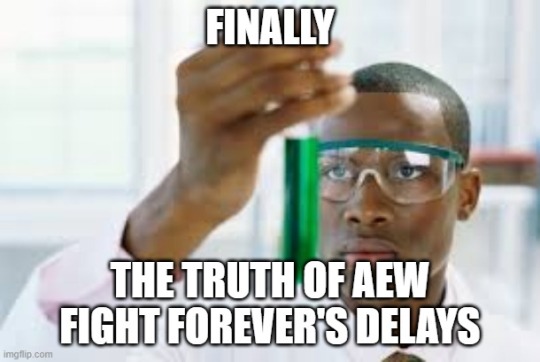
It's remarkable how they managed to miss their targets at every turn. The marketing campaign failed to generate enthusiasm from the publisher or licensee. Promised content has been indefinitely delayed without any clear timelines set by the publisher. The online mode has suffered a quick and merciless death due to the lack of fun matches. Unfortunately, I don't see a future where AEW survives and delivers meaningful updates without continuous funding. I have doubts about the possibility of a complete Season 2.
Despite the potential to become a fantastic, competitive Ranked Fighter, the game's marketing, lack of transparency, and delayed content caused its rapid decline in active players. Even Kenny Omega's lack of personal promotion and enthusiasm echoed the fans' disappointment. With THQ Nordic's questionable marketing strategy and Yukes' inability to deliver a balanced online experience, the game faced insurmountable challenges. Despite promises of ongoing updates, the indefinite delays and lack of communication further alienated players. As the game struggles to survive, the hope for a Season 2 and a meaningful future for All Elite Wrestling's gaming endeavors seems uncertain.
#thq nordic#thq#thq fanart#aew#all elite wrestling#wrestling#aew fight forever#aew ff#fight forever#wwe#wwe 2k#wwe 2k23#kenny omega#aubrey edwards#daniel garcia#adam cole#MJF#maxwell jacob friendman
1 note
·
View note
Text
Marketing Methods THQ Nordic Could Employ For AEW: Fight Forever
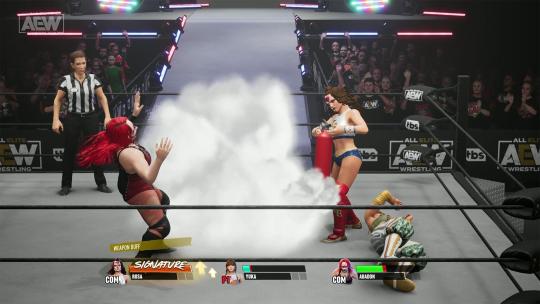
For the last year and a half, fans have been frustrated at the silence regarding the upcoming THQ Nordic and Yukes title; AEW: Fight Forever. It has been nearly two years since it was announced, and very little information is known about what the video game contains. The publisher, THQ Nordic, has remained silent while people like myself beg for the smallest bits of information on social media. “Please Sir, can I have some more?!”
While it’s clear THQ Nordic is taking its time on its marketing campaign and will speak when they are ready, we’ll look at some unique methods THQ Nordic could use to market itself a little bit differently from the competition. This includes marketing techniques ranging from direct involvement from the fans, to cross promotion and even emulating the methods of the old THQ company. Personally, I’ve been a part of the online wrestling game community since 2009. I’ve seen over a decade of changes happen to the community, the video games, and the way they’re marketed. There has been peace, chaos, and mysterious behavior throughout the years. The question is, which one will THQ Nordic choose? At this point, it could seem like the game is shadow dropped for us without an announcement.
Create A Tie-In Dynamite Event
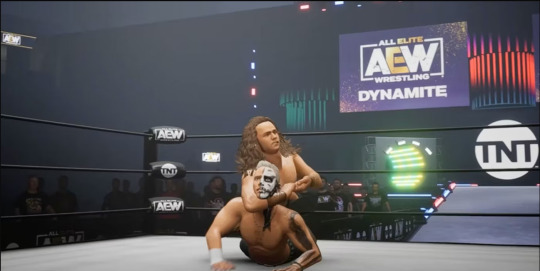
So far, the marketing and enthusiasm for AEW: Fight Forever on its television programs have been extremely minimal. It’s as ground-breaking as watching paint dry. Every few weeks on AEW: Dynamite, the game cover will appear in the corner of the screen with the words “Coming Soon”. This is sometimes accompanied by a commentary sound byte by Excalibur. Real followers of the game – like myself – remember that on an episode of AEW: Dark in August 2022, Excalibur claimed the game was coming in the Fall. We’re six to eight months past that deadline now.
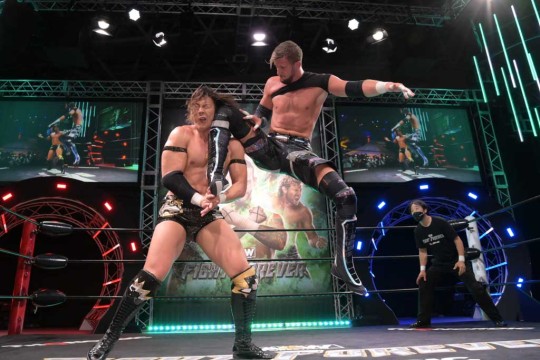
If AEW wants their fans to be enthusiastic about their own video game – which is looking rare on social media – they’ll have to make the fans believe that they, too, are enthusiastic. One possible method for this would be to name an AEW: Dynamite special episode after the game, using the same logos. A smaller scale version of this has already been done. AEW: Fight Forever made an appearance at GamesCom in Germany and Tokyo Game Show in 2022. Select members of the AEW roster were flown out to these gaming conventions, where a pop-up wrestling venue was created on the show floor. The ring and stage were dressed in the game’s logo, making sure everyone knew what was being promoted. Back during this stage, it really seemed like THQ saw the game as something magical to invest in. They were really pulling out the big guns and hosting full wrestling matches at a video game convention. WWE 2K has never had pop-up wrestling events to promote their game, so to me this seemed like a step in the right direction. And then…CM Punk and Kenny Omega got suspended and there’s been silence ever since. That’s not to say there is a direct correlation, but the timing is suspicious.
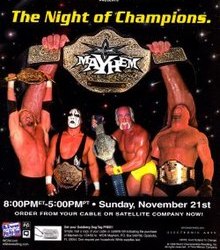
On the AEW side, we’ve not seen much from them. Tony Khan likes to mention the game being near-complete in interviews with wrestling press, however people who only watch the product and don’t engage online could easily forget this game even exists. AEW needs to turn up the gas, and start pushing the game hard. Dynamite is no stranger to special episodes in lieu of Pay-Per-View events. Designing one influenced by their video game, main evented by a huge championship match could drive sales up just from the pure hype alone. It’s not unheard of, either. WCW hosted a Pay-Per-View event called ‘WCW: Mayhem’, the same name as their latest video game at the time. They also released a “Best of WCW” VHS with the same name, finding strength in the brand. Another poster claims that the tape was a pre-order bonus for the video game. AEW: Fight Forever has yet to reveal a pre-order bonus, but a piece of merchandise would go a long way over a digital character.
Sources have indicated to me that the game is coming much sooner than most think, and THQ’s marketing campaign could be quick and like a bullet train. If the game is hypothetically set to release in June, my selfish Canadian self nominates the June 28th edition of AEW: Dynamite from Hamilton, Ontario to be branded AEW Dynamite: Fight Forever. Canadian crowds are hungry for All Elite Wrestling, as their AEW x NJPW: Forbidden Door event in Toronto sold out quickly. The Hamilton crowd will be very hot, seeing as they almost never get televised events. Hosting a championship match with Canadian star Kenny Omega in the main event whilst the video game’s logos are plastered all over would make fans feel hyped up on dopamine and impulse buy the game after the event if they haven’t already. Who doesn’t love falling into the “feeling of missing out”?
Host Competitions And Tournaments For Prizes
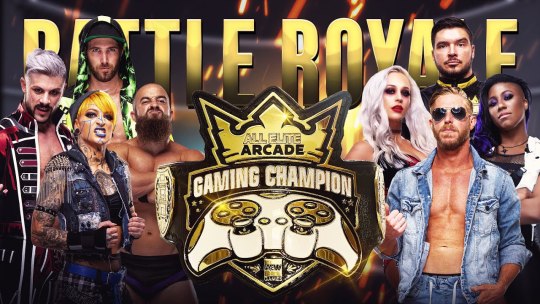
Despite the fact that there has been mostly silence regarding their own video game, AEW has kept a consistent foothold in the video game space with their “All Elite Arcade” Youtube and Twitch series. This channel is similar to WWE’s “UpUpDownDown”. The channel also has video game competitions between AEW wrestlers for the “All Elite Arcade Gaming Championship” belt. THQ Nordic and AEW need to heavily utilize this channel to spread the word about AEW: Fight Forever. Not only do they have to feature their own wrestlers playing the game, but they also need to get the fans engaged with the channel.

Once upon a time, about ten years ago while still under the thumb of the original THQ…@WWEGames on Twitter did massive giveaways. Almost weekly, RAW and Smackdown events had an opportunity for fans to win WWE prizes ranging from copies of the video game, new books, DVDs and sometimes even event tickets. I actually won something myself from one of these giveaways. After 2K took over the account, there were still a few odd merchandise giveaways. Now, they rarely exist beyond a digital code for the video game. Whilst it’s true these things have become expensive to maintain, it’s also true that 2K just isn’t interested in doing it. They are not mutually exclusive. The WWE Games social media has become insanely sanitized and corporate, and AEW could capitalize on this by acting the exact opposite.
First of all, THQ and AEW could host competitions on Twitter and TikTok that involve the video game. Examples of this could be replicating your favorite entrance or taunt in the game, showing off your favorite “markout moment” you’ve recorded, or even your player creations. They could also make it a popularity contest, forcing users to spread their clips in hopes of accumulating likes to win AEW merchandise. The fact of the matter is, players love being engaged with the creators of video games. 2K Sports took this luxury away from us, as the WWE Games account never acknowledges actual discussion. They only reply to tweets that help them to boost their reach. THQ and Yukes have an opportunity here to keep the game alive and growing post-launch by regularly keeping the players engaged with competitions that actually give them an incentive to join.

A second idea would be to host tournaments for players, with finals taking place on the All Elite Arcade channel. The winning player could earn a replica All Elite Arcade championship belt. One of the biggest influences for AEW: Fight Forever is the old AKI Engine wrestling games, such as WWF No Mercy and WCW/nWo: Revenge. These games are heralded as some of the best wrestling titles ever made. Most of the players from that era will tell you that multiplayer was hot and it was incredibly fun to play with friends, myself included. If AEW: Fight Forever hopes to recapture that magic of competitive play, they must encourage the players to try. I’m not a competitive gamer myself but if the environment is nurturing enough, I’d take the leap.
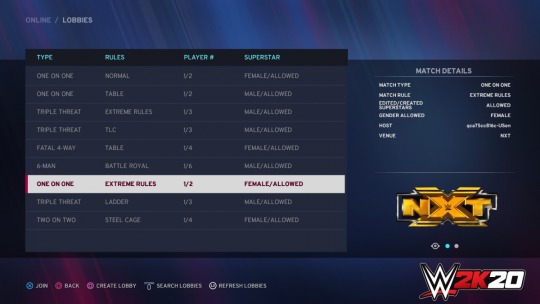
WWE 2K has been failing miserably in making online play fair, balanced, and reliably functional for at least the last decade. When it comes to WWE 2K online, mostly people who have a friend group play online regularly. It’s very rare a casual fan without any wider circle will jump online with random people due to the fact that the gameplay does not foster an online competitive environment. If you’ve ever had a friend group play WWE online, you probably had “House Rules” to follow to make sure nobody exploited some of the game’s native functions.
If Yukes manages to bring a smooth, balanced and fun perspective to online play to Fight Forever, hosting tournaments and filling slots with the player base should come as zero issue. We would actually look forward to competing, and it could become a mini eSport if they play their cards right. But to reiterate, it’s not going to happen without the feeling of being involved and personal with AEW, nor will we feel like we have to enter unless there is an incentive. The prize could be as minimal as an autograph from Ruby Soho, but there will be someone determined enough to win it. This could then break up into content creators hosting their own Fight Forever tournaments for their own prizes, turning it into a splinter of the fighting game community.
In summary, AEW and THQ just need to feed the fanbase regularly. It doesn’t have to be game content updates. It just needs to feel like the game wasn’t dumped to make some money and forgotten about. If the people responsible for its creation aren’t in love with the product, why should I be? Sometimes it seems like THQ just lost interest in the AEW brand. Other times it feels like they’re planning some huge marketing campaign that takes forever to prepare.
AEW Needs To Encourage Creations

It’s very unfortunate that I have to remind AEW fans every so often that they shouldn't expect Fight Forever’s creation suite to be as nearly as robust as WWE’s. But that doesn’t mean it will be unusable, nor does it mean there won’t be some insanely creative community members. Ever since Yukes’ original games like WWE Smackdown: Shut Your Mouth, Here Comes The Pain, and Smackdown vs Raw, members of the community made incredible created wrestlers with limited technology from the early 2000s. Even though WWE 2K may have superior creation tools thanks to over a decade of legacy content, they make one brutal mistake; They don’t promote the community’s creations.
It’s fair to say that they shouldn’t promote created versions of wrestlers not currently signed to WWE, but that doesn’t mean they shouldn’t ignore all creations. There’s nothing stopping them from encouraging people to download a Cody Rhodes Wrestlemania 39 attire creation. Does anyone else remember that back before 2K revoked control of the socials from Visual Concepts, they did occasionally drop some love to mainstream creators like Dre41? WWE 2K has an incredible amount of community creation power behind it, yet you wouldn’t know that if you just follow their Twitter and nothing else. Community Creations is never promoted by 2K, which is odd since it’s the main beef of a wrestling game for many fans.

AEW and THQ Nordic have a chance to completely change the landscape here. We know for a fact that AEW: Fight Forever hosts multiple create modes. The game listing states “Wide range of customization modes: wrestler attire and appearance, move sets, entrances, teams, and arenas”. One example would be centered around Kenny Omega. He regularly comes out with special gear inspired by pop culture, once dressing in Ghostbusters and Undertale inspired attire. If a player created this in the game, the official AEWGames or THQNordic Twitter accounts endorsing it would make the creator feel insanely validated. THQNordic could also use the creation functions as an opportunity for cross-promotion, showing off characters or arenas influenced by their other titles such as Spongebob, Destroy All Humans and Trine.
In a more extreme example, AEW and THQ Nordic could emulate a former WWE contest. After Smackdown vs Raw 2011 was released, THQ and Mattel hosted a contest to turn your original created superstar into an action figure. The winning creation with the most likes from the community would be turned into an action figure. However, the caveat was that only the winner would receive it. So why would I vote on the best if I couldn’t buy one myself?
That contest was so messy it deserves an article of its own. The winning creation can be found in this video. However, it later created controversy across the fan base as the winner was accused of stealing the design from another creator. AEW, THQ Nordic, and Jazwares could try to repeat this contest with better results, such as turning the winning figure into an actual mass produced item in the line. Personally, I would love to own community-created action figures.
Overall, creators just want to feel acknowledged. Flattery goes a long way in creation circles, and having it come from the developers themselves would encourage community members to create more and more content to keep the game alive longer-term. Unfortunately, members of the mod community already have received confirmation that THQ Nordic and AEW won’t condone our work, but that can be remedied by promoting work made by the in-game tools.
Work With Smaller Content Creators
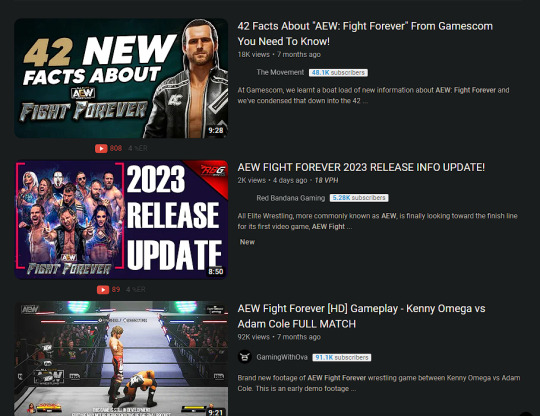
Despite not being a viewer of much of it myself, I have to admit the wrestling game community is in love with YouTube content. Anyone involved in the community follows some of the most popular creators such as Smacktalks. Influencers have incredibly strong reach in the wrestling game space, and there are a lot of young fans who live and breathe on their content. While I do not consider myself an influencer, I do have people who look up to me and ask me for my counsel on things when it comes to wrestling games. 2K knows this all too well, as the bulk of their marketing for the WWE 2K campaigns come from asking the YouTube community to do free labor and advertise the game for them. The slave program is called “2K NextMakers”.
However, THQ Nordic is completely new to the wrestling game space. Do they know of these influencers and how important they are to the community? Do they even know who people like Smacktalks, Vybe, ElementGames, TonyPizzaGuy, WhatsTheStatus and others are?
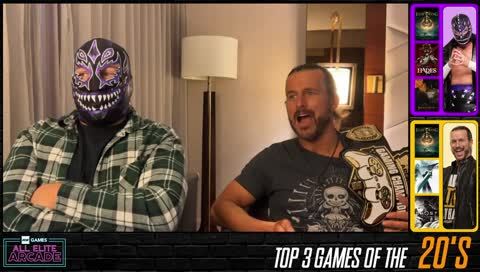
Even if they did, there is a major obstacle in place for THQ Nordic; the 2K Next Makers program. This is the official influencer program for the WWE 2K series, a contractual agreement to help market the game and get access to perks such as free copies of any 2K title. Almost every wrestling game creator with a very high following is a part of this program. From what I’ve heard from anonymous members inside the program, it’s very unlikely their contract would allow THQ Nordic and AEW to provide exclusive reveals or similar “official” marketing partnerships. I’ve also spoken to a few creators who are prepared to leave the program if this ends up being the case.
Though, it’s unlikely many of these creators would jeopardize their pampering to cover a smaller, non-yearly title. Despite this, THQ Nordic could utilize smaller creators and give them a chance to be seen, boost their numbers, and spread positive word of mouth to their small but loyal army of subscribers.
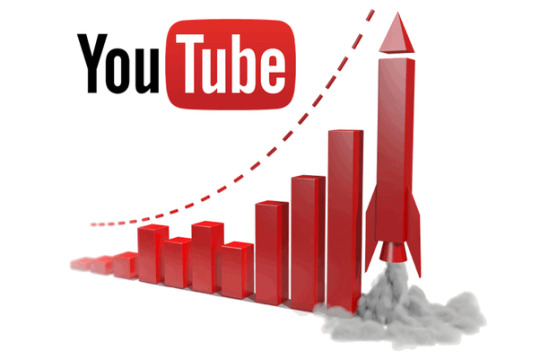
Considering the game is significantly smaller in scope to WWE 2K, it’s only poetic that the creators who get a chance to preview the game also be smaller. This is not to say they should entirely ditch the usual, like IGN or GameInformer. It simply means that channels below a certain milestone (perhaps, under fifteen thousand subscribers) would be able to exclusively post some small tidbit of information, such as a gameplay screenshot.
This would not only make these smaller influencers feel like their hard work has paid off, but also give off the impression that THQ does indeed care about its fanbase and the video game by pushing it through channels you wouldn’t expect. Long term benefits can be seen as the creator would develop a positive bias towards the game, get their numbers boosted by the promotion and continue creating content as long as they enjoy it leading to a longer period for word of mouth.
There are plenty of creators in the wrestling game space who have been busting their ass for years creating content, but are unable to break through the complex algorithm to be seen by major eyes. THQ Nordic and AEW offering some sort of chance to them to break through the ceiling would go a long way in public perception of AEW: Fight Forever.
Look To The Past For Advice
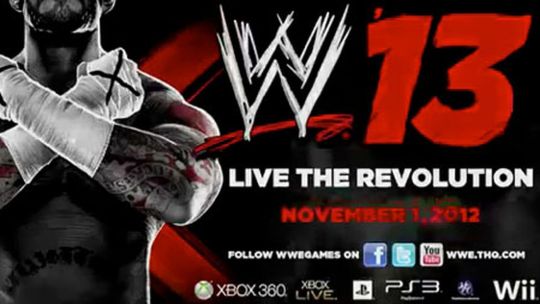
If you ask wrestling game fans about the current handling of the WWE Games Twitter account, you’ll get nothing but displeasure. The marketing campaign tactic nowadays compared to ten years ago with THQ is completely different. 2K opts for more of a “general overview” of the game to target casual gamers who typically do not buy a WWE title. The focus of their campaigns is star power and a spotlight on features in the game such as MyFaction and MyGM. 2K rarely flaunts the wrestling fan service part of these games, unlike THQ where their marketing campaign had wrestling fans as the focal target. Now, one could argue this is why the THQ games never popped off and sold as well as the WWE 2K series has. Though, one could rebuttal it’s simply because 2K has more money to pump into game budget and advertising. In reality, 2K probably has hours of market research to confirm their methods are better. However, there are some strings THQ Nordic can pull from the past to tug at wrestling fans’ heartstrings.
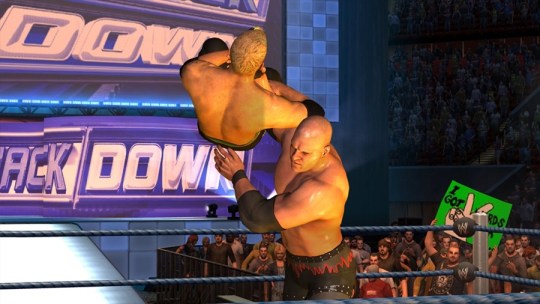
We can all see clearly that THQ Nordic’s main tactic for their catalog is nostalgia. After purchasing the THQ name post-bankruptcy, they also worked on collecting former titles like Thanos and the Infinity Stones. One could speculate this was the main reason THQ decided to publish the next Yukes wrestling game in AEW: Fight Forever. So, if nostalgia is their brand, they need to target that nostalgia hard during marketing. Cut and dry standard advertising is not going to make this game a success.
One of the more favorable methods that THQ employed was weekly entrance videos. There is no doubt at all that wrestling game fans lose their minds over well done entrances in video games. Releasing the entrances of nearly every superstar before launch was a staple of THQ marketing and kept fans engaged long-term. 2K on the other hand, only opts to release the entrance videos of superstars who may go viral, such as Cody Rhodes. Someone with some knowledge of the situation once told me that “2K doesn’t see any value in constant entrance videos”.

Personally, I do not believe the fact that AEW: Fight Forever’s shorter entrance cutscenes are even an issue. The scenes seem to be reminiscent of WWE All-Stars and TNA iMPACT, with them being 15-20 second clips. AEW and THQ Nordic could release 5-10 a week to showcase and keep people engaged long term. Even though they are not full cinematic cutscenes like WWE 2K, they still strive to replicate the television entrances in the best way they can. I fully believe that utilizing regular entrance releases will tap the nostalgia inside fans hearts. They can also be accompanied by raw gameplay finisher animation reveal videos, a tactic also employed by THQ. This would show more transparency to the fanbase, as 2K releases finishers with edits and fake camera work.
One other tactic to gain trust with wrestling fans and tap into nostalgia is to do a developer Q&A. You can watch a sample version for WWE ‘13 featuring Bryan Williams, one of the early creative driving forces on Fight Forever. Whilst the community trusts Bryan Williams, he unfortunately left Yukes last year to return to the WWE 2K franchise. His first title – WWE 2K23 – released in March 2023, still before Fight Forever. It is unknown if Yukes has any English speaking “talking heads” to take on this endeavor. One option would be to host a live-stream with the No Mercy director – Hideyuki Iwashita AKA “Geta” – to talk about how much influence he had on the product. Or, perhaps, the “visionary” behind the game – AEW Wrestler Kenny Omega.

The reason the fans romanticize the THQ era is simple. THQ believed in being honest and transparent as best they could when it came to development. Sure, there were things they couldn’t talk about like WWE’s requests and restrictions. If something was a design choice though, they’d tell you that directly. It wasn’t always sunshine and rainbows. Community Managers such as Marcus Stephenson and Aubrey Sitterson came and went, all of them having different ways of engaging the fanbase. In the end though, answers were always found. It even came down to technical things like Marcus explaining why PS3 had less Create-A-Superstar layer limit than Xbox. If THQ Nordic wants to win over the wrestling game fan base, they have to not only be as transparent as the water in Bikini Bottom, but also use someone who knows what they’re talking about directly from the development team.
TL;DR?
Over the last decade of 2K’s reign as the license holder of WWE, fans have increasingly felt neglected more and more as the years go by. I don’t even look forward to their reveals anymore. The social media handles are becoming more corporate and sterilized by the day. Bugs are not even acknowledged to even exist by the official WWE 2K accounts. AEW and THQ need to tap into that part of the niche that has felt like they are the reason for their parents’ divorce.
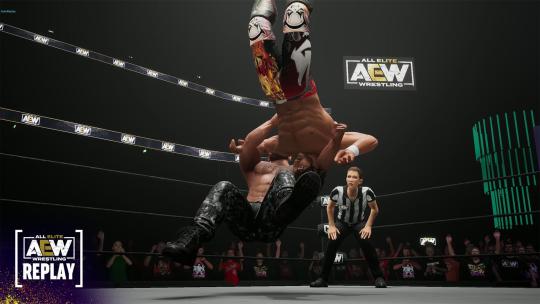
Kenny Omega has a huge opportunity here to herald in a golden era of casual wrestling gaming again, regardless of how polished the game is. Word of mouth is a strong, viable method to help sell this game over the long term when it comes to holiday sales and negotiating for a sequel or more content updates. Consistent patches to fix issues are key to the game’s long term survivability, even without something like Community Creations.
THQ and AEW seem to have a strained relationship to the outside world. People will instantly forget about the mess of waiting for information and constant delays if they work together to put on the best campaign they can for the game. A Dynamite tie-in event featuring big matches would get the entire AEW fan base worldwide interested and engaged. Hosting regular tournaments and giveaways would give people an incentive to buy the game and play more as well as practice competitively. Highlighting the creations made by the players would encourage hard work and repeat usage of the creation suite, even without a Community Creations feature. Smaller content creators would fall in love with THQ Nordic or AEW Games if they got a chance to have their ‘big break’. And as we just mentioned, the old THQ knew how to really break things down for the wrestling crowd, so take a few notes from them.
AEW: Fight Forever has yet to start a marketing campaign, so let’s hope they ponder some of the points I made.
#thq#thq nordic#video games#gaming#pc#xbox#ps3#ps4#ps5#xbox series x#xbox one#nintendo switch#pc gaming#aew#aew rp#aew fight forever#all elite wrestling#pro wrestling#yukes#kenny omega#jon moxley#wwe#wwe 2k23#wwe 2k#smackdown vs raw#wwe smackdown vs raw#retro gaming
8 notes
·
View notes
Text
The Story of WWE Brawl - Blue Tongue, The Avengers Effect, uDraw Tablet, Death of THQ And Brawl’s Legacy
Road to Brawl

In March of 2009, Publisher THQ and Developer Yukes launched WWE: Legends of Wrestlemania, a video game that served as a tribute to the classic WrestleMania events and superstars in WWE’s past. This was the first WWE spin-off title on the newest generation of consoles at the time. In the previous fall, they launched WWE Smackdown vs Raw 2009.
While Smackdown vs Raw 2009 garnered pretty decent reviews, Legends of WrestleMania flopped with its stripped down, quick-time event based gameplay. Fans did not feel engaged enough with LOWM, however the way managers were incorporated into the game is still felt as a high positive to this day. Interestingly enough, the game received “Mixed” reviews from critics, whereas the fans would have you believe it got 1-3 out of 10 ratings across the board with the negative aura that surrounds the game.
Regardless of LOWM’s performance, THQ went back to the drawing board for more WWE spin-offs. Eventually, THQ ordered two from its internal studios. WWE All-Stars – which was to be developed by THQ San Diego (Formerly Midway Studios) – and WWE Brawl, developed by Blue Tongue Entertainment in Australia. During the development of these two games, Yuke’s would continue making the main line WWE Smackdown vs Raw series, next releasing WWE Smackdown vs Raw 2010.

In June 2010, during the E3 (Electronic Entertainment Expo) event week, THQ announced WWE Smackdown vs Raw 2011, WWE All-Stars, and WWE Online (we’ll get to this one another day), however WWE Brawl was not announced at this event. While fans did not know of Brawl’s existence at this time, looking back it’s clear this was the first time it was in some danger, as THQ was touting 3 wrestling video games and Blue Tongue’s was nowhere to be found.
Even though WWE Brawl was being worked on at the same time, WWE All-Stars had been able to progress much faster. This is likely due to the fact that they had a good engine in place already, using Unreal Engine 3 and assets from Midway/THQ San Diego’s previous title, TNA: Impact.
WWE All-Stars released in March 2011 to generally favorable reviews and high fan-fare along with several post-launch DLC packs. It was even nominated for “Best Fighting Game” at the Spike Video Game Awards, an achievement not many WWE games have been able to get. The game was a success from a pure WWE business standpoint. It had made sense to continue the WWE spin-offs. But where was WWE Brawl, after supposedly being in development for two years?
Blue Tongue Entertainment

WWE Brawl would be developed by the studio “Blue Tongue Entertainment'', based in Australia. The company was founded way back in 1995, offering web development services. However, in 1996 they released AFL Fever Finals, and Riding Star in 1998. Very quickly, this earned them enough prestige to be given existing intellectual properties to adapt. Their next game would release in 2000 and was a tie-in to the 1997 film of the same name; Starship Troopers: Terran Ascendancy. The following game would be an adaptation of another classic film franchise; Jurassic Park: Operation Genesis which was their first release on a video game console.
In November of 2004 after the release of Operation Genesis, video game publisher THQ would acquire Blue Tongue Entertainment. THQ and Blue Tongue were already working together on the 2004 release of Polar Express. "THQ's long-standing licensing relationships and global publishing capabilities have made them a great partner over the past couple of years," said Steven Spagnolo, CEO, Blue Tongue Entertainment. This partnership with THQ led Blue Tongue Entertainment to become one of their leading Nickelodeon game developers.
Their following titles would be one based off of the film Barnyard, and three games under the Nicktoons banner. Their final Nickelodeon game would be El Tigre: The Adventures of Manny Rivera for Playstation 2. Blue Tongue Entertainment became a premiere developer for content aimed at a younger audience. This was also in line with WWE’s content shift in the late 2000s and early 2010s, being dubbed the “PG Era” of WWE. Perfect match, right?

However, before the studio got an opportunity to create a WWE game, THQ offered the company a chance to adapt a video game they had acquired from a small team of students from Utrecht University. Blue Tongue Entertainment released de Blob in September of 2008, a puzzle platformer. The game received rave reviews, such as gaming giant IGN calling it "one of the best third-party efforts to come over to Wii in a long time". It has since become a classic that spawned a sequel, 2011’s De Blob 2, and ports to modern hardware.
Fun fact, de Blob and WWE Brawl share something in common: both have lost ports. While all playable versions of WWE Brawl are deemed currently lost, de Blob had an infamous DS port in production that at times was rumored not to even exist. However – with how often liquidated THQ assets are traded – in January 2023 the YouTuber RebelTaxi acquired a dump of De Blob DS and was able to release it to the public.
In between the two de Blob titles, Blue Tongue obtained the Marvel license and released a child-targeted video game in 2009 titled Marvel Super Hero Squad. The game was based off of the Hasbro toy line of the same name. While the game didn’t play well with critics, it must have impressed Marvel enough. THQ and Marvel would eventually release a sequel in 2010 titled The Infinity Gauntlet, but this time developed by Griptonite Games. One would assume Blue Tongue was busy starting work on WWE Brawl, however another title’s development stood in the way. Marvel had ordered The Avengers from THQ and Blue Tongue.
The Avengers

While Blue Tongue Entertainment were working on WWE Brawl, they were also tasked with providing help to THQ Australia on a video game based off of Marvel’s The Avengers. Blue Tongue were tasked with porting the game to Windows. The game was to be a “first person brawler”, with up to four player co-op multiplayer locally and online. The game was to be released around the time of Marvel Studios’ upcoming film of the same name, however there would be no actual ties to it. The video game’s storyline was reportedly written by Brian Michael Bendis and an adaptation of his famous comic storyline, Secret Invasion. An in-depth dive on The Avengers can be found at Unseen64.
The reason this article brings up The Avengers is because it shares something very much in common with WWE Brawl. They were both canceled, and presumed to be lost media. Both games were being developed by THQ in Australia, and both were shut down in an attempt to save THQ from bankruptcy. However, one major difference between them is that a partial build of The Avengers has been dumped online and fully playable. A website called ObscureGamers obtained a copy. One of its members had acquired old THQ hard drives, and was able to dump a hard drive clone that contained a build of the game. The build is dated July 14th, 2011 and is downloadable from the Archive.org database.
Even though it was the Xbox version that was leaked (Developed by THQ Australia, while Blue Tongue handled Windows), one could hope that Blue Tongue’s WWE Brawl is still on the cards for being leaked the same way. It took a decade for The Avengers, maybe it’ll take a little more for WWE.
The Remnants of WWE Brawl

Unfortunately, WWE Brawl was never officially revealed by THQ. The first mention of WWE Brawl existing came from WWE Corporate in a “Corporate Initiatives” video. The hyperlink to that specific page, and the original full video is now seemingly lost, however the section for Brawl still exists thanks to TonyPizzaGuy. The trailer features gameplay footage of various superstars performing over-the-top combat in a variety of stylish environments, spliced with concept art of finishing moves that probably had yet to be programmed or animated. The Undertaker is shown to be doing a move called “Soul Crush”, which wraps the opponent into a dark trap in a style similar to fighting games like Marvel vs Capcom. Amongst the environments shown are a Graveyard map, a Subway or Metro City, what looks to be an Egyptian Film Set and a burning Junkyard. The video ends with concept art key art of Triple H, John Cena, and who one can assume to be Kelly Kelly. A final screen displayed promises a 2012 release date, with Xbox 360, PS3 and Wii as the release platforms. Blue Tongue Studios was not mentioned.
This would be the first game along with WWE ‘12 to ditch Playstation 2, Playstation Portable and Nintendo DS as release platforms for the WWE line of video games, committing fully to the then current generation of consoles years after their release.

However, it has been revealed that a 3DS port was planned for WWE Brawl. The first and only WWE game fully released on the Nintendo 3DS is a post-launch port of WWE All-Stars in 2012. Upon doing research in a Discord group for sharing prototypes for video games – ObscureGamers – I had encountered a Japanese auction for a WWE Brawl prototype on the 3DS. The description mentions that you can make wrestlers in cosplay, which could hint at a Create a Wrestler mode. The listing mentions it was canceled during THQ’s bankruptcy but fully playable. It doesn’t seem as if this auction had sold, nor has it seemingly been dumped anywhere. Upon referring to this auction to an anonymous source, they didn’t deny a port had existed, but rather in fact said they expect it to be dumped before any other platform’s version. Blue Tongue artist Alex Ries told us that they didn’t have any knowledge of a 3DS port as an artist.

The auction also has various screenshots taken of the prototype, showing combat in progress in a developer test environment. One screenshot seems to contain a more complete environment. This version of the game only had 16 selectable characters, as opposed to 18 in the console prototype.

Brawl Game Design

Initially, WWE Brawl’s original foundation came from a single idea internally being called “WWE Smash Bros”. We were told that it was pitched that way during it’s recruitment phase. Super Smash Bros is a 2d platform fighting game that has been thriving for over two decades. In actuality, WWE Brawl ended up being more 3D arena brawler allowing the player to move freely within a full 3D Environment while battling. It was akin to the classic fighter Power Stone, and later games of similar style like Marvel Nemesis: Rise of the Imperfects.
The game would boast a roster of re-imagined WWE Superstars in fantastical outfits with powers beyond any human comprehension fighting in various destructible and interactive environments. The prototype menu shows the potential for 18 playable characters, although more could have been added later in development.
A few characters had their own environments based off of their personality, presumably where their boss fight would have taken place in the final campaign. Some examples include John Cena having his own auto garage, Edge was in charge of a night-club styled arena, Triple H had a dark throne room and Rey Mysterio hosted a Mexican Plaza space. All of the environments would be fully destructible, with the linked concept art showing a “before a fight versus after” versions of the environments.

Gameplay was described to be very “fast-paced and destructive” according to senior artist Drew Morrow in an interview with WWE.com. Brawl would take the action to the fictional “Brawl City”. The campaign mode would have the Superstars trying to take down a fictionalized evil Mr. McMahon. Unlike in the previously mentioned Power Stone and Marvel Nemesis, the environments of WWE Brawl would be much tighter and enclosed to still capture the feel of having a space that feels as enclosed as a wrestling ring.
Years ago in their retrospective, WWE.com also released the very first raw gameplay videos of WWE Brawl. Stone Cold vs The Miz was backed up on YouTube.
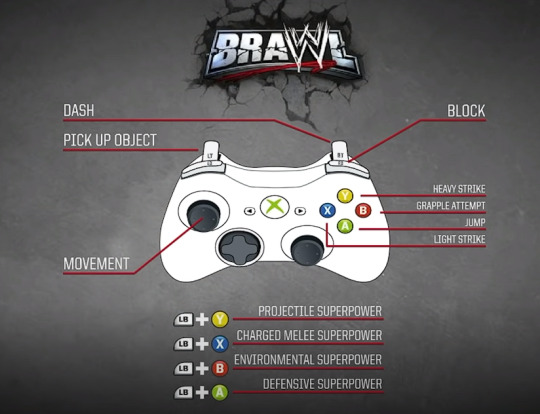
The Gameplay video shows multiple selectable attires for each Superstar with former WWE ring announcer Justin Roberts providing the voice over announcement of the character you select. Upon selecting your character, the game shows you what seems to be your character's superpower icons, as well as a choice to equip stones that seem to provide buffs for the match. Upon loading into the start of the match, characters had a voice over introduction similar to that of Street Fighter and Mortal Kombat.
The controls for the game were relatively simple, especially when compared to Yukes’ Smackdown vs Raw series. Movement was standard and on the left thumbstick, the character could dash by holding Right Trigger. Left Trigger would be used to pick up objects in the environment, and left bumper would be a modifier that allows the face buttons to execute Superpowers. As for the face buttons, X (on Xbox) would be a light strike, Y would attempt a heavier, stronger strike, B would attempt to grapple the opponent and A would allow the character to jump on objects and platforms in the environment.

The Art design of WWE Brawl started with the intent of possibly being spun-off as an animated series. Early designs showed a more streamlined aesthetic that seemed in line with contemporary children’s animated movies.
Initial test designs had Darren Tibbles creating 2D Animation to see if the designs were compatible with future spin-off projects. “So, we wanted to make sure the characters could work in 2D. I created some 2D test animations and looked at creating all the cutscenes as 2D animation.” said Tibbles in an interview with WWE.com.
Later along the way of the development, the art-style took the shape of a more “tough” style. The characters became bulkier, the colors became darker, more detail was drawn into the models as it started straying away from the fairy-tale Disney style of animation.

Environments were fully sketched out and some were near perfectly replicated in the final game. Most of the environments can be seen on the Artstation of Alex Ries, who told us nothing but good things about his time at Blue Tongue. “I was a regular artist since late 2007 and worked on the Marvel project Super Hero Squad 3. I learned a TON, as it was over many years. I trained in 3D and developed my career as a concept artist while there” said Ries.
You can see many of his artworks for the video game on ArtStation. Ries also told us some of his favorite work for the game was the environmental arenas, stating “I like the big environment artworks I produced, particularly the arenas”.
If there’s one thing Blue Tongue Entertainment was able to finalize, it was the art-style. Rumors point to multiple creative production issues along the way for the game, especially being around 3 years old by the time it was revealed by WWE Corporate.
In an effort to help out, the THQ “Fight Group” was assigned to the game. The Fight Group was a group of people who are shuffled amongst different WWE projects to help guide them along. Regular names included in this group were Cory Ledesma, Bryan Williams, Jason Vandiver, Arnaud Frey and others.
However, Brawl seemed especially troublesome when its sister game WWE All-Stars released so fast and easily. WWE.com’s interview also noted that the story had not settled in a final place, and was still undergoing writing changes when the studio closed and development had ceased. They note that the game had “early growing pains and some late developmental gains”, but was also “six months to a year from completion”.
Ries told us that he didn’t even get a chance to properly play the game; “I never got to experience tests of the gameplay so dont know how the game would have felt, or if it could have been popular. We didn't make it very far before it all collapsed”.
From a complete business perspective, it makes sense as to why THQ picked WWE Brawl as one of its first projects to shelve. The game failed to make huge progress with seemingly most of its time being spent on pre-production. The roster at the time of cancellation was the smallest of any notable THQ WWE game to date. The game did not progress at the speed a publisher would want, it was just contributing to THQ’s ongoing money sink. Could Blue Tongue have been allocating too many resources to the PC version of The Avengers?
THQ Bankruptcy & Death of Brawl

The original THQ was beloved by gamers and wrestling fans on the surface level for many years. The products were niche and catered to certain markets at most times (Nicktoons, WWE, etc) and seemed to work just fine. However, at a management level, THQ had many problems festering for years and made bad financial decisions across the board. The biggest nail in the coffin was the uDraw tablet, an absolute disaster that was one of the direct reasons for THQ’s financial death.

The original uDraw tablet was conceived as a Wii peripheral, a drawing tablet comparable to those for digital artists. Included was a software called uDraw Studio, where Wii users could learn to and also create works of art on the scale of professional artwork. Early analysts predicted the peripheral could sell up to one million units easily, and THQ promised a three to five year commitment. The uDraw for Wii saw enough success for THQ to continue investing into it. Popular gaming website Joystiq said "simple mostly-white design makes it a perfect companion for the Wii". THQ decided to double down on the uDraw, releasing a black version for Playstation 3 and Xbox 360 a year later in November 2011. Ten more titles were commissioned by THQ, using the uDraw tablet to enhance gameplay mechanics. Some of those titles were SpongeBob SquigglePants, The Penguins of Madagascar: Dr. Blowhole Returns - Again, Marvel Super Hero Squad: Comic Combat and Pictionary: Ultimate Edition.
Unfortunately, the uDraw flopped tremendously on the Playstation and Xbox consoles – an audience which mostly demanded edgy, adult-oriented products at the time. The investment caused the company to lose over 100 million in unsold stock alone.
"From a contribution margin perspective, we would have doubled the profitability in the quarter were it not for uDraw. So it was something in excess of $30 million in operating loss in the quarter as a result of uDraw." said CFO Paul Pucino in an investor Q&A. "Sales of the uDraw GameTablet and related software, and other titles in the kids, family and casual category were far weaker than anticipated, substantially reducing our financial results for the quarter," said CEO Brian Farrell.
In February of 2012, THQ admitted defeat and ceased all development and further creation of all uDraw brand related products. In their quarterly earnings call, they reported a net loss of 55.9 million dollars.

Even though the uDraw cannot be directly linked to the end of WWE Brawl, its impact on THQ Australia/Brisbane and Blue Tone Entertainment ended the long reign of development for the 1995-founded Aussie studio. THQ had closed down all of their Australian operations in a “strategic realignment”. Most people note that the Australian dollar was too high at the time to keep these studios running. I wouldn’t have kept them around to make niche market games.
From an outsider’s perspective, it seems that THQ closed down projects and studios that weren’t progressing in order to make the uDraw on Playstation and Xbox a bigger success. Unfortunately, none of that can be confirmed.

In November of 2012 – about one year after the closing of the Australian studios and failure of the Xbox 360 and Playstation 3 versions of uDraw – THQ Inc had reported that they could not pay back a 50 million dollar loan from Wells Fargo and filed for Chapter 11 bankruptcy. In desperate attempts to earn back some money, THQ did various actions such as selling a new “Full Package” version of Saints Row: The Third, delaying games like Metro: Last Light, introduced a “THQ Humble Bundle”, which was a bundle of classic THQ games for a price the customer could choose. The bundle raised a reported 2-5 million dollars for the company, giving fans some hope their cherished publisher could survive. On December 19, 2012, THQ’s bundle effort proved to be for nothing as they filed for Chapter 11 bankruptcy, attempting to sell their assets to Clearlake Capital Group so they could continue business privately. A judge denied the bid and ordered THQ to sell off its assets individually and cease operations, ending a true era in video gaming.
In a quick summary of what happened to the THQ assets, Homefront went to Crytek, Warhammer went to Sega, and the WWE franchise landed a new home at Take-Two Entertainment, who was able to complete Yukes’ final solo entry on the game and release it under a new banner and name; WWE 2K14. All assets that failed to be auctioned off, including the brand itself, was acquired by Nordic Games who eventually launched a new successor; THQ Nordic. Whilst THQ Nordic lost the WWE license, in 2021 they were confirmed to be the publishers of the upcoming Yukes wrestling game, AEW: Fight Forever. This marks the first time Yukes and THQ’s brand names are on a title since WWE 13. Sources have indicated to us that AEW: Fight Forever is currently slated to be released in late April or May.
Brawl vs All-Stars: The Differences

One has to wonder that with both games being ordered in 2009 – was there a feud between WWE All-Stars and WWE Brawl to be released first? Sources indicate no, there wasn’t. Both games were intended to be released on schedule, and more WWE spin-offs presumably would be coming in the future had THQ not folded. Another one in production that didn’t lift off was WWE WrestleFest. It just seems that sadly, Blue Tongue took a really long time in pre-production to find a version of Brawl they were satisfied with, and by that time it was too late. Let’s take a look at the key differences between WWE All-Stars and WWE Brawl.

The first key difference between WWE Brawl and WWE All-Stars is the environment in which the games take place. In All-Stars, matches take place in the traditional WWE setting. An arena venue with a full crowd and a standard (albeit inaccurately sized) wrestling ring to contain all the action. Players can freely leave the ring to grab weapons, and bounce off the ropes and turnbuckles to create devastating high flying attacks. Each venue available in the game was based off a real WWE event, giving players the feeling that they are in a fantastical WWE setting.

WWE Brawl opted to get rid of the WWE venues entirely, and even the removal of spectators watching the action. WWE Brawl had each map being a fictional district that the city inhabits. Sgt. Slaughter’s level was a war-torn battlefield area whereas The Undertaker’s level was the city's dark, gloomy graveyard. In WWE Brawl, most of the environmental weapons are swapped out from traditional wrestling objects to use the city’s destructive remnants and set dressings.
Players could pick up pieces of destroyed buildings and everyday objects like patio tables, but a kendo stick would be a rare find. It is unknown whether or not Brawl would have added spectators in the finished product, but the environments feel quite lifeless without them. Unfortunately, sources – including Ries, could not give us more information on the lore of Brawl City.

Both WWE All-Stars and WWE Brawl boast over the top animations and gameplay. Despite that, they play very differently. WWE All-Stars is a tight, fast-paced grapple-oriented game. Grapples and strikes connect seamlessly and are the main method of combat similar to pro wrestling itself. Wrestlers can bounce off the ropes and dive off the turnbuckle posts for high flying moves that can transition into reversals and “juggle combos”, a feature that was highly praised by fans.
WWE Brawl, however, is less wrestling oriented. There doesn’t seem to be a constant “targeting” system that is present in most wrestling games, making attacks more of a “aimlessly swinging” mechanic. Grapples are present, however, and gameplay videos look like there is potential to lead into juggling. Players are not enclosed in a traditional wrestling ring, but rather the environment boundaries create a tight ring-like space to force combat between the two opponents. While it’s assumed one could climb objects in the game and dive off of them, there is no video evidence of such a mechanic. It’s possible that WWE Brawl did not contain any diving.

WWE All-Stars roster seemed to be more robust compared to what we know about WWE Brawl. All-Stars boasted a roster of over 30 WWE Superstars, with more added via post-launch DLC packs. Its “Fantasy Warfare” mode gave them the luxury of having an equally balanced roster of legends and then-current WWE Superstars. This included famous legends such as Andre The Giant, Bret Hart, Hulk Hogan and The Rock. WWE All-Stars also managed to bring Macho Man Randy Savage back into the WWE family for the first time in many years. The present day roster included big names such as Triple H, John Cena, Randy Orton, Kofi Kingston and Sheamus.
WWE Brawl, however, didn’t seem to have much of a balance towards that idea. Its roster seemed to be driven by characters selected by the writers of the story.
Of all the released concept art for the game, we can confirm the following roster members were possibly final; The Undertaker, Sgt. Slaughter, Rey Mysterio, Triple H, Edge, John Cena, Sheamus, The Miz, Randy Orton, Randy Savage, R-Truth, The Big Show, Stone Cold Steve Austin, Kane, Kofi Kingston, Batista, Ted DiBiase, and Hulk Hogan. Oddly, The Rock is missing despite being a mainstay in nearly every WWE video game.

While sources could not indicate what engine WWE Brawl ran on, WWE All-Stars ran on Unreal Engine 3. Not only that, it already had a game base to start off with as the studio formerly already made a wrestling game; TNA: Impact. This gave All-Stars a massive head start as fundamental code had already been written and in place for a WWE title, it just needed heavy modification to make their dream a reality. Considering Blue Tongue Entertainment had never made a 3D brawler before, one could assume it required much heavier work to get a prototype in place for WWE Brawl.
These are just some of the differences between the two games that illustrate the fact they would hit two different demographics and both are worthy of release. Despite the fact that WWE Brawl was lacking compared to the scope of All-Stars, I still think it would have been an enjoyable game to play, especially online. The concept came together well enough in the end but it is obvious why THQ decided to cut it to save some money.
Brawl Post-Mortem & Autopsy

It’s unfortunate that WWE Brawl never made it into the hands of gamers. Most purist wrestling fans wouldn’t mind, but the niche fanbase of over-the-top variants of WWE Superstars in outlandish environments still feel a hole in their heart at the loss.
Over the years, though, both WWE All-Stars and WWE Brawl have left a legacy and influence on WWE video games that would come in the future. There have been video games that simply feature caricatured graphics in a realistic wrestling combat setting like WWE All-Stars and games that take the WWE Superstars out of the ring into stylish worlds to wage war against each other similarly to WWE Brawl. While there’s no proof that Brawl had any influence on the games that followed it, gamers can get a taste of what it would’ve been like through these titles. The closest a person can get to Brawl was the mobile title WWE Immortals.

WWE Brawl was set to release in 2012, but gamers had to wait 3 more years to get a taste of fantasy fighting with WWE Superstars. In January 2015, Warner Bros Interactive published WWE Immortals on mobile devices which was developed by NetherRealm Studios – the studio behind Mortal Kombat.
Immortals features over the top, comic book-like versions of WWE Superstars fighting in meticulously detailed crazy environments such as the pits of hell, haunted swamps and graveyards. The combat had nothing to do with professional wrestling, but instead was a traditional fighting game with special finishers inspired by the real life wrestling move counterpart. Just these two sentences alone sound a lot like it could be describing WWE Brawl. However, veteran mobile gamers were a bit upset that the game was merely a clone of the already released Injustice: Gods Among Us Mobile. Immortals did well enough to continue service for three years until its closure at the start of 2019, when their license with WWE expired.

In the years since Brawl’s unfortunate demise, prototype collectors and wrestling fans have always been curious about more information about the game.
It is considered a “white whale” to myself, and I have been checking every THQ liquidation asset dump for a hint of the WWE Brawl prototype’s existence since. This game could even be entirely lost, as it is unknown what happened to Blue Tongue’s assets after their closure. The game also never had any presence at a floor show like E3, so the chance of a showcase demo leaking is even slimmer. In an attempt to get more information, I cold messaged Blue Tongue’s old Facebook page. Whilst I didn’t receive a reply to my questions, Facebook Messenger indicated to me that it was actually read, and a person still operates that page.
One interesting thing to note in the recent years since WWE Brawl’s death is that the trademarked was renewed in 2021 by WWE, for video game software as well. Does this mean that WWE Brawl is resuming development and releasing? Extremely unlikely, but it does mean the name itself could return.
Perhaps it could be reserved for a future mobile game, or perhaps it is the name of the mysterious WWE Role-Playing Game mentioned by Stephanie McMahon in 2022. Further information about this mysterious game is unknown, but sources with knowledge of the situation have confirmed to me that it was never a 2K Sports title, but most likely expanding the license to other publishers. Could we hear about a brand new WWE Brawl in the coming years? Could it be the game birthed from the EA/WWE contract talks reported by Mike Straw?
To any collectors who may have WWE Brawl, whether it be the console prototype showcased on WWE.com or the 3DS Prototype leaked on a Japanese auction site, please dump it for preservation's sake! Archive.org would be a fantastic place to host it. If you have more information on WWE Brawl that wasn’t covered in this article or previously known, feel free to contact me. WWE Brawl was truly an enigma of a video game – never announced but consistently remembered due to being one of the few failed WWE projects mostly developed.
Would you have bought WWE Brawl, had it been completed?
#wwe#wwe brawl#wwe 2k#wwe 2k22#wwe 2k23#smackdown vs raw#wwe smackdown vs raw#wwe raw#wwe smackdown#xbox#xbox 360#playstation#playstation 3#gaming#video games#lost media#wrestling#pro wrestling#john cena#the rock#stone cold#triple h#hulk hogan#thq#thq nordic#marvel#the avengers#marvel's the avengers#iron man#hulk
0 notes